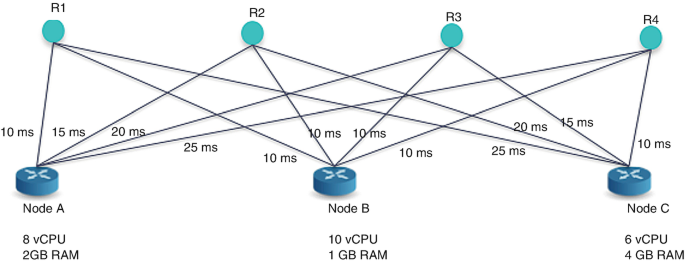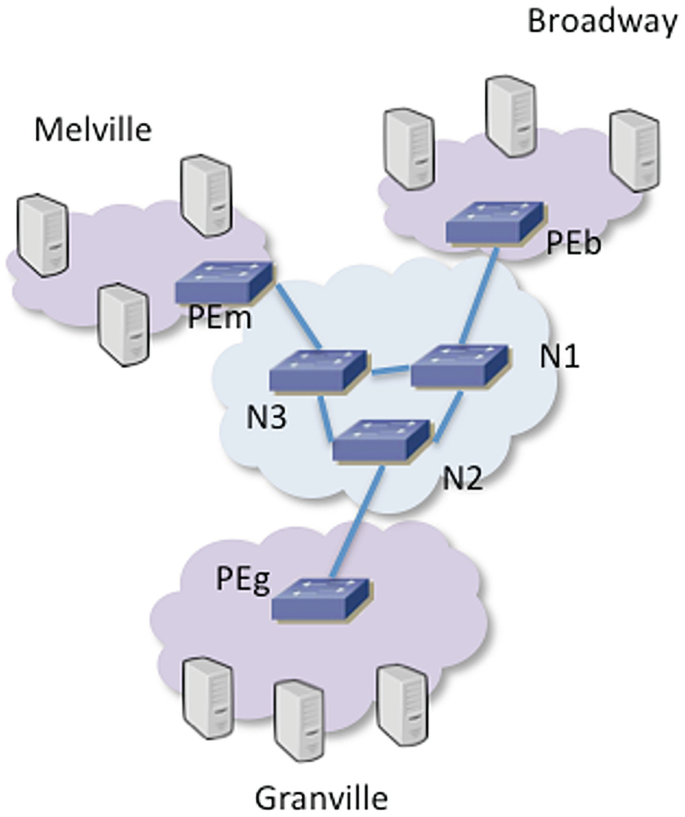Abstract
l. This chapter defines Fog Computing, a platform for integrated compute, storage and network services that is highly distributed and virtualized. This platform is typically located at the network edge. The chapter discusses the main drivers for Fog: Data Deluge, Rapid Mobility, Reliable Control and finally Data Management and Analytics. It describes the characteristics of Fog, which uniquely distinguish it from Cloud Computing. It then focuses on the pre-requisites and enabling technologies for Fog Computing: Virtualization technologies such as Virtual Machines and Containers, Network Mobility solutions including EVPN and LISP, Fog Orchestration solutions to manage topology, things connectivity and provide network performance guarantees, and last by not least Data Management solutions that support Data In Motion and distributed real-time search
Access this chapter
Tax calculation will be finalised at checkout
Purchases are for personal use only
Notes
- 1.
As quoted by Eric Schmidt, Executive Chairman of Google
References
Nielsen's Law of Internet Bandwidth, J. Nielsen, April 5, 1998, Online: http://www.nngroup.com/articles/law-of-bandwidth/
M. Yannuzzi, et al., Key ingredients in an IoT recipe: Fog computing, cloud computing and more fog computing, IEEE 19th international workshop on computer aided modeling and design of communication links and networks (CAMAD), December 2014
F. Bonomi, et al., Fog computing and its role in the Internet Of Things, SIGCOMM 2012
P. Mell, T. Grance, The NIST Definition of Cloud Computing, National Institute of Standards and Technology Special Publication 800–145, (2011)
S. Nanda, et al., A Survey on Vritualization Technologies. http://www.ecsl.cs.sunysb.edu/tr/TR179.pdf
Docker, www.docker.com
T. Kondo, et al., A mobility management system for the global live migration of virtual machine across multiple sites, Computer software and applications conference workshops (COMPSACW), 2014 IEEE 38th international, July 2014
A. Sajassi, et al., BGP MPLS-Based Ethernet VPN, IETF RFC 7432, February 2015
Y. Rekhter, et al., Network-related VM Mobility Issues, draft-ietf-nvo3-vm-mobility-issues, work in progress, June 2014
D. Farinacci, et al., The Locator/ID Separation Protocol (LISP), IETF RFC 6830, January 2013
Y. Hertoghs, M. Binderberg, End Host Mobility Use Cases for LISP, draft-hertoghs-lisp-mobility-use-cases, work in progress, February 2014
C. Morales, A Vision for Fog Software and Application Architecture, Fog Computing Expo, November 2014
M. Uddin, et al. Graph search for cloud network management. Network operations and management symposium (NOMS), 2014 IEEE, May 2014
E.J.H. Chang, Echo Algorithms: Depth Parallel Operations on General Graphs. IEEE Trans. Softw. Eng SE-8(4) (1982)
M. Ruta, et al. Resource annotation, dissemination and discovery in the semantic web of things: a CoAP based framework. IEEE international conference on green computing and communications and IEEE Internet of Things and IEEE Cyber, Physical and Social Computing, 2013
Author information
Authors and Affiliations
Problems and Exercises
Problems and Exercises
-
1.
Will Fog computing replace Cloud computing? Why or why not?
-
2.
What is the definition of Fog computing?
-
3.
What are the characteristics that uniquely distinguish Fog from Cloud computing?
-
4.
What makes containers lighter-weight virtualization constructs compared to virtual machines? Why is this attribute of containers important for Fog?
-
5.
What are the two problems that all network mobility solutions aim to address?
-
6.
Why can’t traditional data management and analytics techniques be applied to IoT?
-
7.
What three functions should a Fog orchestration solution address and solve?
-
8.
What is “Data in Motion”?
-
9.
Why are semantic search mechanisms important for IoT?
-
10.
Consider the following Fog domain shown in the figure below. For each Fog node, the diagram shows the number of virtual CPUs (vCPU) and RAM available. Also, the communication latency from each node to a remote sensor (labeled R1 through R4) is captured.

There are five applications that need to be placed on the Fog nodes, and each application has specific demands for CPU, RAM, and communication as depicted in the table below:
Application | CPU demand (vCPU) | RAM demand (GB) | Communications demand |
|---|---|---|---|
1 | 5 | 0.5 | R1 (< 12 ms) |
2 | 2 | 1 | R2 |
3 | 1 | 0.25 | R3 |
4 | 1 | 1 | R4 |
Find the optimal placement of the five applications on the three Fog nodes such as to minimize the communication latency between each application and the sensor that it needs to connect to.
-
11.
A Fog domain is using EVPN to support workload mobility. The topology of the domain is as shown in the figure below. Every BGP speaker requires approximately 10 milliseconds to process a BGP message, including any transmission/reception delay. A VM moves from the Melville server farm to the Granville server farm.
-
(a)
If N1, N2, and N3 form a BGP route-reflector (RR) cluster (i.e., fully meshed BGP sessions) and each of PEb, PEg, and PEm have a BGP session with their directly attached RR, how long would it be before all other applications are capable of communicating with the VM in its new location assuming it takes 20 millisecond for GARP messages to be received and processed by the PE connected to the new server?
-
(b)
If N1, N2, and N3 are MPLS core routers, rather than route-reflectors, how does the above convergence time change?

-
(a)
-
12.
An IT administrator is trying to decide on whether to use Linux container or virtual machine for an interactive location-based interactive marketing application. Each instance of the application requires 200 MB of RAM to run, including all dependencies/libraries. The Linux distribution she is considering has a runtime memory footprint of 800 MB. A given application instance needs to move frequently in the Fog domain, to maintain close proximity to a target customer and deliver an immersive HD video/audio experience. Assume that the wireless links interconnecting the Fog nodes operate at 100 Mbps.
-
(a)
In the best-case scenario, how long would it take for the memory image of the application to move from one Fog node to another in the case where the application runs in a virtual machine?
-
(b)
Repeat (a) for the case where the application runs in a Linux container.
-
(c)
Which virtualization construct should the IT administrator pick for her application and why?
-
(a)
-
13.
A smart parking application is implemented in the future city of Metrotown using Fog computing. Fred is looking for parking in Metrotown’s downtown shopping district. His car is capable of communicating automatically with the city infrastructure to locate available parking. The Fog domain in Metrotown is such that Fog nodes are placed roughly 50 meters apart, on street lighting poles. The car’s embedded application is searching for parking availability within a 1 km radius from the current vehicle’s location. Assume that the Fog domain is using the Echo algorithm to search for data. If node processing latency and link propagation latency are 2 milliseconds and 1 millisecond, respectively, how long would it be before the search request has reached all nodes in the Fog domain?
-
14.
A Fog orchestration system is responsible for the mobility of workloads among three Fog nodes dispersed in three locations: Coal Harbor, Yaletown, and West End. The choice of a server for a given workload is a function of the CPU load of that server and the network communication latency from the server to the client. The orchestrator assigns a score between 0 and 1 to each server based on its CPU load, with a score of 1 for servers having less than 25% utilization, a score of 0.5 for servers with utilization between 25% and 75%, and a score of 0.25 for utilization above 75%. The orchestrator ranks the servers based on network latency and assigns them a score between 0 and 1 linearly depending on their rank in the ordered list, with a score of 0 assigned to the server with the highest latency and a score of 1 assigned to the server with the least latency. Assume that a user on her smartphone is roaming between the three locations. The network latency from her phone to the Coal Harbor Fog node is 200 microseconds, to the West End Fog node is 300 microseconds, and to the Yaletown Fog node is 250 microseconds. The average CPU utilization for the servers is 80% for Coal Harbor, 13% for Yaletown, and 50% for West End Fog nodes.
-
(a)
If the Fog orchestrator is configured to give equal weight to communication latency as server CPU load, which server would the orchestrator select?
-
(b)
If the communication latency carries twice the weight of the server CPU load, what would be the server that the orchestrator selects?
-
(a)
-
15.
Explain the difference between the three different levels of virtualization: CPU instruction set level, hardware abstraction layer (HAL) level, operating system level.
-
16.
What distinguishes LISP from other networking solutions that support mobility?
-
17.
Describe Nielsen’s Law. How does it relate to Moore’s Law? What are the implications for IoT?
-
18.
How is network connectivity different in the Fog from the Cloud?
-
19.
How does rapid mobility impact communicating IoT applications?
-
20.
When you conduct a search on your favorite web search engine, is the search conducted over the Internet in real time? Will this model work for IoT?
Rights and permissions
Copyright information
© 2019 Springer Nature Switzerland AG
About this chapter
Cite this chapter
Rayes, A., Salam, S. (2019). Fog Computing. In: Internet of Things From Hype to Reality. Springer, Cham. https://doi.org/10.1007/978-3-319-99516-8_6
Download citation
DOI: https://doi.org/10.1007/978-3-319-99516-8_6
Published:
Publisher Name: Springer, Cham
Print ISBN: 978-3-319-99515-1
Online ISBN: 978-3-319-99516-8
eBook Packages: EngineeringEngineering (R0)



